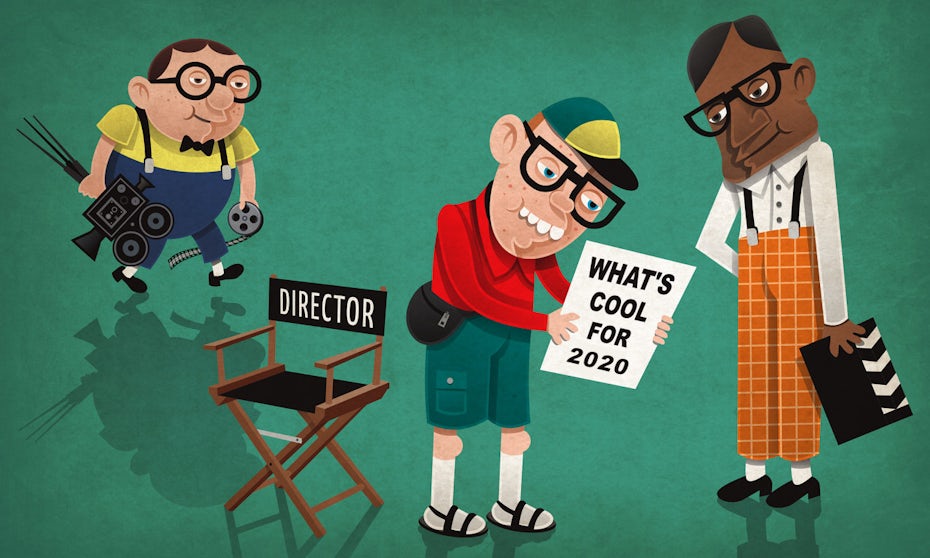12 innovative video marketing trends for 2020
Each year the ever-growing video sector sees trends come and go.

While it may not be wise to jump onto trends too quickly, it’s good to keep an eye over them as you continue your quest to optimize your video marketing.
So far this year, we’ve seen some trends ramp up, and others start to fade away. It can be hard to keep up, so we’ve done the work for you. These are the video trends to keep an eye on over the next year.
1. Facebook Live may be dead, but live video lives on
—
Facebook Live was one of the biggest busts of 2017. In fact, not many of Facebook’s video initiatives have garnered great results for video creators. Facebook Live, Facebook Watch and regular auto playing Facebook videos have seen publishers chasing views and following this prophecy without great results, resulting in the complete shut down of some of them.
But live video isn’t a trend that’s disappearing altogether. On the contrary. Live video has secured a firm place in the video ecosystem. But what that is exactly, remains to be discovered.

The concept of live media is still an incredibly engaging one. The secret ingredient? Live interactions with real people.
As an Instagram or Snapchat user, you’re probably noticed that many people you follow “go live” multiple times a day. Those live feeds usually consist of answering questions that are being submitted in real-time by other users—maybe even attempting to do something that users request.
This kind of content is designed to take advantage of the ephemeral nature of the moment.
While Instagram provides the ability to save these live events to your profile, the odds of someone watching an hour-long live stream later are quite unlikely. This is what makes this style of video so powerful.
It’s recreating the sensation live radio and TV used to command—people all around the country, or the world, experiencing the same thing at the same time.
Live video is here to stay. So keep experimenting with the medium.
2. Videos will become “shoppable”
—
Another trend that’s picking up steam is “shoppable videos.”
These are video ads that feature links to products within the world of the video.
Instagram Stories and Snapchat feature a lot of these, but the technique is becoming more sophisticated.

It’s reasonable to predict that you’ll soon be able to buy products or get links to them by interacting with those objects within a video. If there’s a chair featured on screen, you may be able to hover over it and find out more about that particular model and where to get it.
The same may go for a mobile phone that’s being reviewed in a YouTube video.
The options are limitless, really. But for now you’ll see more videos that highlight specific products in a story’s stream, often with a shoppable link (or a link to an exclusive deal).
3. Interactive 360 video technology will expand
—

Interactive 360 video is a huge trend at the moment. Through it, I’ve been able to experience broadway musicals, sports games and iconic locations.
It’s the kind of immersive, futuristic video style we’re expecting to see a lot more of as AR and VR continue to grow in usage. And it’s something that, if you’re ambitious enough, you may want to try yourself.
While not easy to produce (just yet) it could be a great way to set your product videos apart from your competition and really captivate your customer base.
4. 1:1 video experiences will continue
—

While software like Google Hangouts and Zoom have been improving their video conferencing ability drastically, video experiences featuring just one person talking to another person live still have a place—and this type of experience is positioned to grow.
The ability to see another person and to share screens lends itself quite nicely to technical support. Beyond that, it can also be a good way to teach.
There’s nothing quite like seeing another person and looking them in the eye to truly communicate effectively. The intimacy of video conferencing trumps communicating via a voice call, chat app or sending an email.
5. Everyone will be vlogging
—
Vlogging is one of those video genres that’s easy to poke fun at but hard to ignore.

As many changes as video platforms like YouTube have gone through, vlogging continues to grow. Now you have YouTube, Instagram and Snapchat as popular vlogging platforms. With the addition of live streaming as a feature, vloggers are diversifying the type of content they present. In some cases, they’re turning live streaming into their weekly or daily vlogging content and creating more polished videos that drop on YouTube once a week or once a month.
Whether this helps or hinders the burnout problem is arguable either way. But one thing is for certain, vlogging is not going anywhere anytime soon.
6. Videos will be easily searchable
—
Just as social networks have integrated video into their core offerings so too have search engines like Google.

Over the past few years, videos have inched closer to the top of organic search results on both desktop and mobile pages.
Now, things are progressing further, with Google’s announcement that they’ll be using AI to identify snippets of video related search queries and have these autoplay on search results pages.
This will make video even more important to effective search optimization for brands and businesses.
It will also increase the importance of optimizing your video content for search results—just like you would with an article you’re hoping will rank well in search.
It’s a continuation of the importance of video to the discovery of your business or brand.
7. Training and education videos will expand
—
Training and education are already a huge sector of the internet that utilizes video. Think Masterclass, Skillshare and even video tutorials you can find for free on YouTube, or that get charged for through various sites on the internet.
This trend will continue to grow, as I suspect brands and businesses that sell products will start creating their own content to teach people how to use their products.
What’s interesting about this trend is that people, in increasing fashion, already go looking for videos to answer how-to questions more often now than in the past. For how-to questions, videos are justifiably more useful content.

I recently bought an entire bedroom’s worth of furniture from Ikea, and totally blanked on the fact that I’d need to put everything together myself.
I was stunned to discover that Ikea doesn’t provide detailed instructions. That’s an understatement. Their instructions, designed, much like their products, only include what’s necessary. The company works to be as global as possible, so the instructions include images, but no actual words, making them very hard to understand.
I finally came up with the bright idea to look for a video tutorial. I found an entire community of YouTubers who have created whole channels about constructing Ikea furniture.
It delighted me to find these, but the quality of some of the tutorials was hit or miss. This seems like a big opportunity for Ikea to create instructional video content themselves.
My guess is that at some point we’ll see that happen. If Ikea, one of the biggest furniture and lifestyle brands in the world, isn’t doing their own video tutorials, I would confidently assume there are a lot of other brands who aren’t making their own content either.
I expect to see this start to change, adding even more momentum to this continually growing genre.
8. There’ll be more “stories”
—
As mentioned in the vlogging section of this article, ephemeral stories, as in stories that only exist for a certain period of time, have become a new form of vlogging.
Because they’re mostly done in the moment, and are low-fi and don’t require editing, they’ve lowered the bar for people who have always wanted to be video personalities.
If you’re an Instagram or Snapchat user, you’ve probably noticed that some of your friends have become amateur video personalities.

We’ll see this style of video continue to gain prominence as platforms like Facebook, YouTube and even Medium introduce ephemeral stories.
Similar to podcasts, one of the reasons this is an exciting platform is that people will watch and aren’t going to be overly picky about what they see and the quality they expect.
This means that we could even see things advertised within these streams of video.
Podcasts have done this sort of midstream style of advertising quite successfully. They’re usually presented by the show’s presenter and sometimes can be live to tape and off the cuff.
They work because with these personality-based types of content, most viewers or listeners are there because they have an intimate connection with the presenter or personality. Seeing or hearing them recommend a product is really effective.
As advertisers look to invest more in this style of advertising, expect to see ephemeral stories continue to take off.
9. More platforms with more video dimensions
—
As more video platforms get introduced, the preferences for video dimensions, whether your video is in square, horizontal, or vertical format, will expand.
With Snapchat and Instagram Stories, vertical video has increased its popularity dramatically. In fact, YouTube and Facebook video support it.

But, IGTV, Instagram’s video platform, hit a wall when they tried to push its users to upload vertical video content. A lot of people ended up freebooting content from YouTube and rotating ninety degrees to fit the vertical dimensions. And due to the generally low usage of it, Instagram has now announced they’ll support normal horizontal video in IGTV.
A similar journey has been undergone with square video. At one point it was thought that square video content performed better on Facebook, and was more fit for Instagram, whose content was usually posted and rendered into a square. But, since then, the platform has started supporting photos in broader dimensions, and videos as well. The square video is generally less present on Facebook and a trend YouTube never fully embraced.
Will we see more square videos in the next twelve months, or have things returned to normal dimensions? Is it vertical video for good? We’ll see. It’ll be good to pay attention to this space.
10. We’ll all be watching silent videos
—
When Facebook introduced its autoplay feature, which automatically plays videos within your stream with no sound, it was a game changer. Although it later admitted that it was counting a minimal amount of seconds as full views, no matter how long or short the video was, the idea of watching videos without sound caught on.

I’m not sure Facebook ever thought so far ahead as to predict that people would elect to watch whole videos without turning the sound on, but that’s what ended up happening, as publishers created videos with subtitles and enough animations and imagery to give context over what they were watching with no need to turn on the sound.
Now Instagram autoplays videos in its feed. So do LinkedIn, Twitter and YouTube.
As autoplaying videos continue, so too does the consumption of videos with no sound.
11. Video ads will become immersive, midroll and longer
—
As mentioned in the 360 video section, immersive video, experiences in AR or VR, are gradually increasing, and so is the interest in them.
Immersive stories are the next frontier for ads. Immersive ads have the potential of giving users a sense of what their life will be after buying or using a particular product.
Imagine being able to simulate the product you’re selling, allowing users to see which color would suit them best or how the product will fit into their life?
Or a productivity tool that consumers can interact with so they can see their schedule being organized in a new and intuitive way. That’s the potential of immersive ads. Combining VR or AR with your live camera to get a product into the hands of potential users—albeit virtually—is compelling. Expect to see more of it.

Mid-roll ads are still being introduced, slowly, and carefully, by platforms. Facebook has been talking about them for a while, but has yet to roll them out in a significant way. YouTube has dabbled in it over the years.
The goal appears to be to bring video ads and the video experience, on some level, back to the days of linear television, with ads popping up in the middle of videos or shows, with no option to skip them.
The problem with small videos on platforms like YouTube and Facebook is that often these videos aren’t long enough, or formatted in a way that lends themselves to an interruption like an ad. But expect platforms and advertisers to keep exploring this concept.
Video ads are getting longer. According to MediaRadar, from January 2018 to February 2019, the number of 6-second video ads on YouTube declined by 20% year over year while the number of 30-second ads increased to 19% to 24% of all ads.
Along with the length of ads on video, another change will be the duration of the ads that play on sites like YouTube before users can skip. They’ve experimented with increasing it to 15 seconds on the Google-owned video platform, apparently the sweet spot of not too short and not too long to explain your product or pitch.
This trend is set to continue in the next year.
12. More showing less explaining
—
Finally, showing, not explaining, is a trend that will evolve and continue in video content.

Video allows us to do more than just provide an explanation in text or as a voiceover. It can allow us to just show what things look like, how they work, what they’re made of, and how they can fit into your life. Sometimes all without words. Think Masterclass, putting Ikea furniture together, the immersive ads trend and the silent videos trend.
What video trends do you want to explore?
—
As is always the case in this ever-changing sector, video marketing trends come and go, sometimes very quickly. That doesn’t mean that they shouldn’t be explored. The key is to ensure that whatever you’re trying fits into your strategy and has a good chance of working for your audience. Try to avoid going “all-in” on something untested.
Over the years we’ve seen publishers like Mashable and Mic completely restructure their businesses to produce video content for Facebook, or go all-in on live video, ending up facing major lay offs because the market wasn’t there for that type of content. Make sure that doesn’t happen to you by approaching trends, not as a silver-bullet solution to growth or exposure, but rather as experiments that might help you resonate with your audience in new and compelling ways.
If they don’t work, you can write those experiments off. If some of them catch on, then, gradually, they can become a more significant part of your video marketing strategy. Explore them all! Trying new things is the only way to innovate and potentially get the edge over your competition.